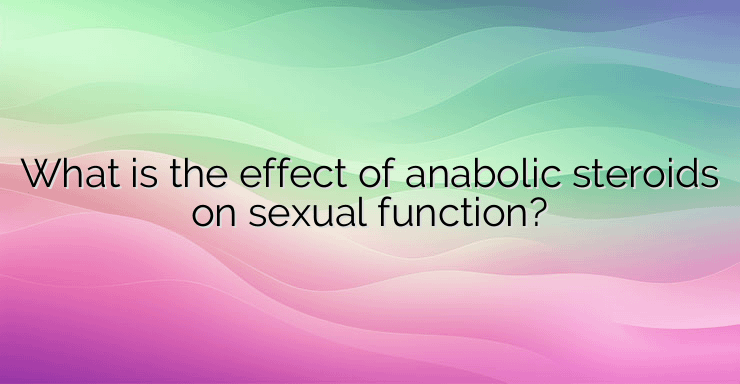Testosterone is the main male sex hormone that leads to the development of secondary sexual characteristics in men (androgenic effect) and increases muscle mass (anabolic effect). Testosterone was first discovered in the 1930s, and since the 1950s, the first synthetic testosterone analogs have been created to increase its anabolic effects. The use of testosterone replacement therapy is approved for the treatment of hypogonadism, osteoporosis, and delayed puberty. Unfortunately, the use of testosterone preparations without medical indications in order to achieve greater success in sports or from a purely aesthetic point of view is becoming more common. Anabolic steroid use sometimes has serious side effects, such as liver and heart damage, hypertension, depression, gynecomastia, polycythemia (increased red blood cell count), testicular atrophy, and infertility. Anabolic steroid-induced hypogonadism is a common cause of infertility in young men. The use of anabolic steroids has long been out of the bounds of professional sports. Studies have found that 15-30% of male gym goers use such preparations. In addition to testosterone, other hormones with an anabolic effect are also used – growth hormone, gonadotropins, insulin, as well as estrogen receptor blockers. Unfortunately, many of the nutritional supplements sold contain anabolic steroids that are not even listed in the ingredients list. The most common reason that motivates the use of anabolic steroids is the increase in muscle mass and the reduction of fat. Men who use them tend to continue taking them for fear of losing the muscle they have gained, as well as withdrawal symptoms. The reason for the deterioration of general well-being after discontinuation of steroid intake lies in hypogonadism (reduced function of the testicles). The use of testosterone preparations leads to suppression of the release of gonadotropic hormones from the pituitary gland – luteinizing and follicle-stimulating hormone (LH and FSH). This is how the so-called hypogonadotropic hypogonadism. That is, the stimulus that provokes the testicles to produce testosterone, as well as normal spermatogenesis, is removed. The duration of hypogonadism after discontinuation of anabolic steroids is unclear. Some studies show that it lasts from 4 to 12 months, while in others it can be very long-lasting and even irreversible. Usually, the mode of administration of testosterone preparations is different from that used for replacement therapy. Testosterone is administered at a more frequent interval or steroids are used, which have mainly an anabolic effect – muscle hypertrophy. The most commonly used are nandrolone, stanazol, methandienone and trenbolone. Often bodybuilders use a combination of several androgens, which can have a direct toxic effect on the testicle. Common side effects of anabolic steroid use are testicular atrophy, fluid retention,acne and gynecomastia. Withdrawal or hypogonadism symptoms appear during the steroid withdrawal period. These are depression, erectile dysfunction and decreased libido, muscle weakness, insomnia. The diagnosis of hypogonadism requires the examination of serum levels of testosterone, LH, FSH, sex-hormone binding globulin (to calculate free testosterone) and prolactin. Complete blood count and hematocrit, lipid profile, prostate-specific antigen are examined. Treatment for low testosterone levels includes hormone replacement therapy in combination with selective estrogen receptor modulators (tamoxifen). If there is no effect after 4 weeks of treatment, human chorionic gonadotropin (hCG) is administered in order to restore the pituitary-testicular axis and stimulate the own testosterone secretion. If there is no improvement in testosterone levels after 8 weeks of CHG treatment, it is assumed to be permanent testicular failure, necessitating permanent testosterone replacement therapy. Erectile dysfunction is treated with 5-alpha phosphodiesterase inhibitors (sildenafil). Often, in patients who used anabolic steroids, there are serious disturbances in the spermogram and infertility. It is believed that up to 4-12 months after discontinuing these agents, spermatogenesis is also restored. It is important to treat the underlying hypogonadism. This is done by using CHG in combination with estrogen receptor inhibitors. References: 1. Rahnema CD, Lipshultz LI, Crosnoe LE, Kovac JR, Kim ED. Anabolic steroid-induced hypogonadism: diagnosis and treatment. Fertil Steril. 2014 May;101(5):1271-9. doi: 10.1016/j.fertnstert.2014.02.002. Epub 2014 Mar 14. PMID: 24636400. 2. Coward RM, Rajanahally S, Kovac JR, Smith RP, Pastuszak AW, Lipshultz LI. Anabolic steroid induced hypogonadism in young men. J Urol. 2013 Dec;190(6):2200-5. doi: 10.1016/j.juro.2013.06.010. Epub 2013 Jun 11. PMID: 23764075.Erectile dysfunction is treated with 5-alpha phosphodiesterase inhibitors (sildenafil). Often, in patients who used anabolic steroids, there are serious disturbances in the spermogram and infertility. It is believed that up to 4-12 months after discontinuing these agents, spermatogenesis is also restored. It is important to treat the underlying hypogonadism. This is done by using CHG in combination with estrogen receptor inhibitors. References: 1. Rahnema CD, Lipshultz LI, Crosnoe LE, Kovac JR, Kim ED. Anabolic steroid-induced hypogonadism: diagnosis and treatment. Fertil Steril. 2014 May;101(5):1271-9. doi: 10.1016/j.fertnstert.2014.02.002. Epub 2014 Mar 14. PMID: 24636400. 2. Coward RM, Rajanahally S, Kovac JR, Smith RP, Pastuszak AW, Lipshultz LI. Anabolic steroid induced hypogonadism in young men. J Urol. 2013 Dec;190(6):2200-5. doi: 10.1016/j.juro.2013.06.010. Epub 2013 Jun 11. PMID: 23764075.Erectile dysfunction is treated with 5-alpha phosphodiesterase inhibitors (sildenafil). Often, in patients who used anabolic steroids, there are serious disturbances in the spermogram and infertility. It is believed that up to 4-12 months after discontinuing these agents, spermatogenesis is also restored. It is important to treat the underlying hypogonadism. This is done by using CHG in combination with estrogen receptor inhibitors. References: 1. Rahnema CD, Lipshultz LI, Crosnoe LE, Kovac JR, Kim ED. Anabolic steroid-induced hypogonadism: diagnosis and treatment. Fertil Steril. 2014 May;101(5):1271-9. doi: 10.1016/j.fertnstert.2014.02.002. Epub 2014 Mar 14. PMID: 24636400. 2. Coward RM, Rajanahally S, Kovac JR, Smith RP, Pastuszak AW, Lipshultz LI. Anabolic steroid induced hypogonadism in young men. J Urol. 2013 Dec;190(6):2200-5. doi: 10.1016/j.juro.2013.06.010. Epub 2013 Jun 11. PMID: 23764075.


Leave a Reply